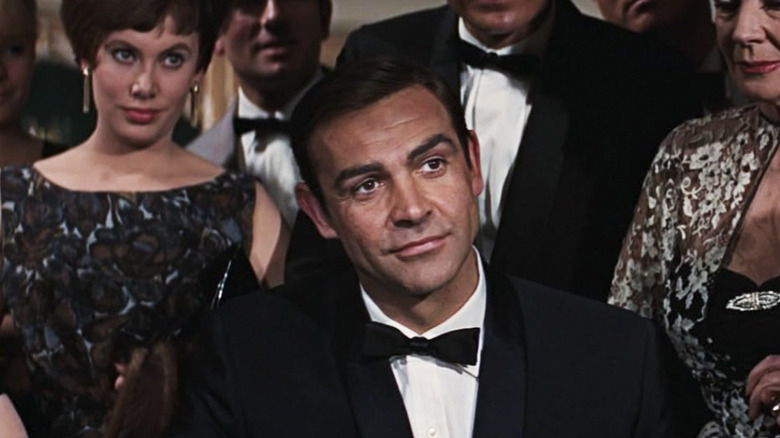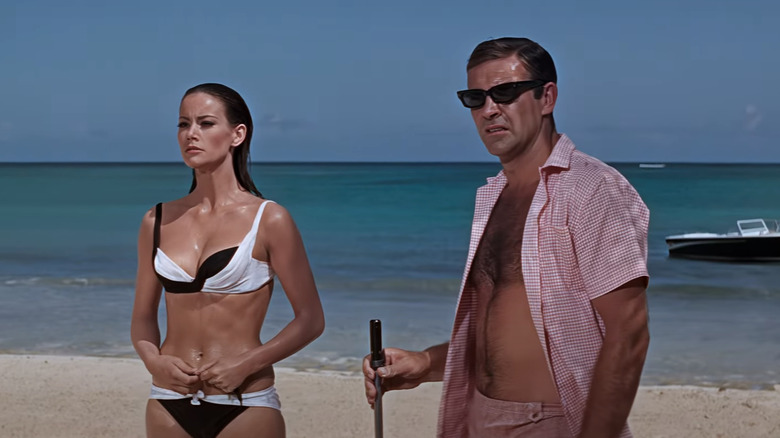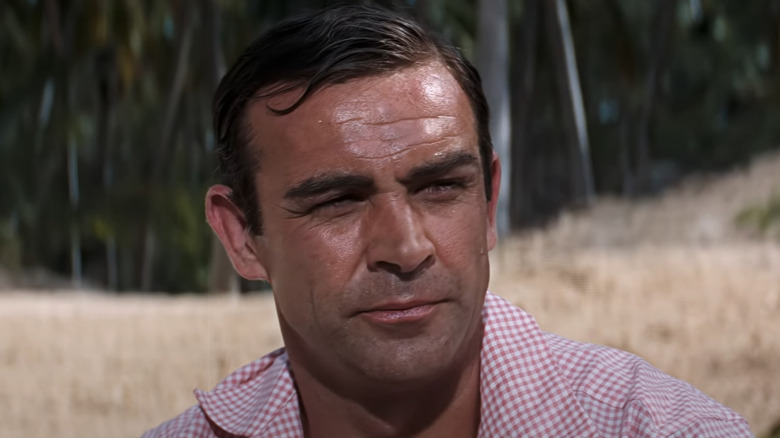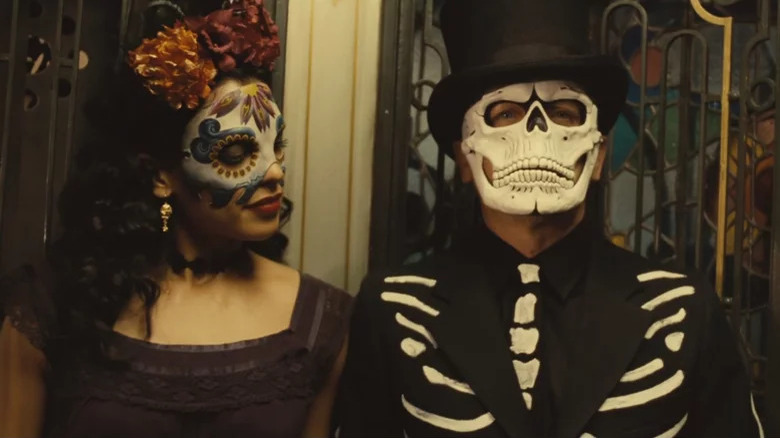Thunderball Was A Legal Landmine For James Bond Author Ian Fleming
When it comes to the Sean Connery James Bond movies, the highest praise is usually reserved for "Goldfinger" or "Dr. No." The latter was, of course, Bond's on-screen debut, while the former introduced so many of the trademarks we've come to expect from the franchise, it's arguably even more of a Bond blueprint than "Dr. No."
But while it might not be considered the greatest James Bond film, Connery's fourth outing in the tux, "Thunderball," is a significant entry in the saga. The fourth Bond movie made $141 million, making it the most successful Bond at the time — a title it retained (adjusting for inflation) until 2012's "Skyfall." "Thunderball" was also the last time director Terrence Young would oversee a 007 movie, having helped define the character's fashion sense, humor, and bon vivant persona with "Dr. No." But the fourth Bond outing is also significant for the behind-the-scenes controversy that accompanied it.
We all know that 1962's "Dr. No" was the film that kicked off cinema's most enduring franchise, followed by "From Russia With Love" in '63, and "Goldfinger" in '64. Then, the following year, came the fourth movie: "Thunderball." Ostensibly based on Fleming's 1961 novel of the same name, the movie actually had its roots in a screenplay the author had helped craft along with his collaborators, Kevin McClory and Jack Whittingham. This script was originally intended to be the first James Bond movie, with a story designed specifically for the screen rather than being based on any of Fleming's previous novels. Unfortunately, despite spawning a book and ultimately being made into a film (twice), this script became a legal landmine for the author and the company behind the Bond movies, Eon Productions.
Burned out on Bond
Sean Connery always felt Ian Fleming's novels missed a key ingredient of the Bond formula — namely, humor. But as Fleming continued writing his spy series, more and more levity would find its way into the pages of his novels. By the time the posthumously published "The Man With the Golden Gun" arrived in 1965, Bond was about as dryly funny as he'd ever been on-screen, replying to villain Francisco Scaramanga's assertion that some people who'd never heard of him were "dead" with the jibe: "A lot of people who haven't heard of me are dead."
Of course, Sean Connery, with the help of Terrence Young, had really defined much of Bond's sense of humor, and Fleming took some cues from the actor's portrayal, writing Bond closer to his on-screen persona after "Dr. No" debuted in 1962. While part of that was undoubtedly down to the fact that the films had proven so popular, Fleming was also faced with having to churn out a novel a year, and would take his inspiration wherever he could get it. In one instance, that meant taking inspiration directly from the screenplay he'd helped develop prior to James Bond's on-screen debut.
In a letter to his friend and former Naval Intelligence colleague William Plomer (via The Independent), Fleming wrote that he was "terribly stuck with James Bond," adding that "what was easy at 40 is very difficult at 50." Under pressure to produce yet another Bond adventure in 1961, the then-53-year-old author turned to the screenplay he'd originally intended as a way to introduce Bond to the movie-going public. And that was where the trouble began.
The original Thunderball
Kevin McClory was an Irish writer and director whose 1959 film "The Boy and the Bridge" impressed Fleming. The author originally envisioned McClory directing Bond's cinematic debut, and McClory then introduced the author to Jack Whittingham, an established screenwriter who would help write the script. By late 1959, a screenplay was completed. Eventually becoming known as "Thunderball" after several other titles were considered, the script included ideas and contributions from Fleming, McClory, and Whittingham. Unfortunately, production would stall due to numerous factors, including losing funding and Fleming's inability to secure a director (at one point, he was intent on having Alfred Hitchcock replace McClory).
Edward Gross and Mark A. Altman's "Nobody Does It Better" is an oral history of the James Bond movies, and features comments from several of the key players who were around at the time the original "Thunderball" was being developed. As Altman and Gross explain, Fleming was growing frustrated with the pitfalls of Hollywood, and returned to his Jamaican home, GoldenEye, to start writing the ninth Bond novel.
McClory recalled that, "For whatever reason, he went away, and he wrote, at GoldenEye, a novel called 'Thunderball,' but it was written from our screenplay." "On Her Majesty's Secret Service" director Peter Hunt explained it this way:
"Fleming had run out of ideas, or was running out of ideas, and said, 'Oh, I might as well write and publish this script as a book.' Then, of course McClory said, "You can't do that. You haven't even said that I contributed to it or Jack Whittingham did."
'The next thing I know, it's published'
To be fair to Kevin McClory, he did have a point. As he explains in "Nobody Does It Better": "I knew [Ian Fleming] was writing a novel, but I didn't know he was writing a novel on 'Thunderball.' And the next thing I know, it's published, with no credit for Whittingham or myself."
McClory and Jack Whittingham tried to prevent Fleming from publishing the book, which led to a lawsuit that finally ended in the London high courts in 1963. McClory won the film and TV rights to the story, allowing him to legally produce James Bond movies based on the novel. Furthermore, the book was required to state that it was based on a screenplay by McClory and Whittingham in all future publications. As McClory recalled:
"I was assigned all the film and TV rights to 'Thunderball.' I said to Fleming, 'You have the literary rights; you wrote the novel, I don't want you to part with that. But you put in every novel that this is based on a screenplay by us.' This is the legend it's supposed to have; some publishers do, some don't."
By 1963, Fleming was struggling with his health, and had even suffered a heart attack during the court case, so it was somewhat in his interests to wrap things up. But even after the author passed away from another heart attack in 1964, the Bond franchise would be haunted by the fallout from this legal battle.
The specter of Thunderball
After departing the James Bond franchise following 1967's "You Only Live Twice," Sean Connery would return briefly for 1971's "Diamonds Are Forever" — an underrated Bond movie deserving of more respect. But even after Roger Moore took on the mantle of 007 in 1973's "Live and Let Die," Connery would once again return. This time it was in 1983's "Never Say Never Again," a remake of "Thunderball" orchestrated by none other than Kevin McClory.
Ian Fleming's trustees tried legal action to stop the film from being made, despite McClory previously winning the 1963 legal battle. But this new case was thrown out, clearing the way for Connery to return as Bond in a film that had nothing to do with Eon Productions or Fleming's estate. What's more, McClory retained the rights to the memorable SPECTRE organization, the villainous group which had first been conceived for the original "Thunderball" script.
The legal issues continued even after this, when (per Variety) McClory tried to claim partial ownership of the James Bond character via a federal suit filed in Los Angeles. This time it was McClory who found his case thrown out when, in 2000, the judge reportedly stated that the writer had taken too long to file the claim. McClory passed away in 2006, but in 2013, distributor MGM and Danjaq (the holding company for the James Bond copyrights and trademarks) acquired whatever rights were still held by the McClory estate, providing the Bond producers with complete control of the Bond legacy after decades of legal issues. This would, of course, lead to SPECTRE being reintroduced into the Eon films in 2015's "Spectre" — a somewhat underwhelming conclusion to a truly epic legal odyssey.




